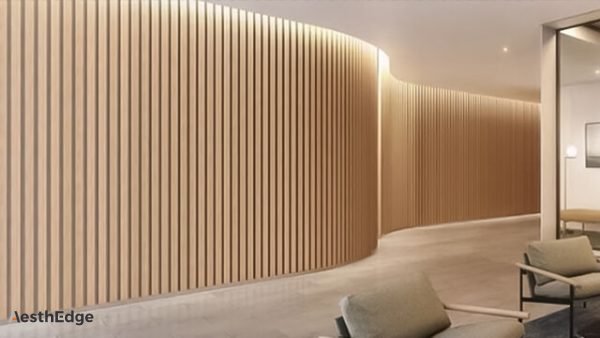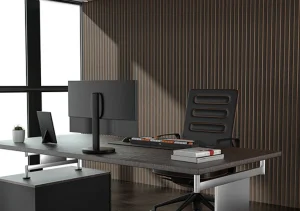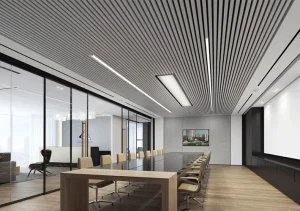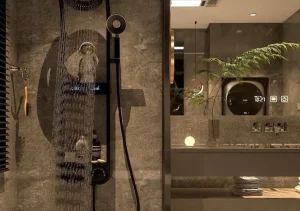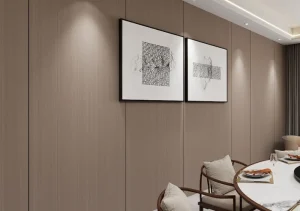Table of Contents
ToggleIntroduction
In the decorative materials industry, choosing the right wall and surface finishing materials is crucial for both aesthetics and functionality. Among the many options available on the market, PVC marble sheets and bamboo charcoal wood veneers have emerged as two of the most popular choices for residential, commercial, and hospitality projects.
Although both materials are used for interior decoration, they differ greatly in terms of composition, appearance, environmental impact, durability, cost, and application scenarios. This article provides a comprehensive comparison between these two materials from a professional perspective, especially for overseas B2B buyers, importers, contractors, and designers looking to make informed purchasing decisions.
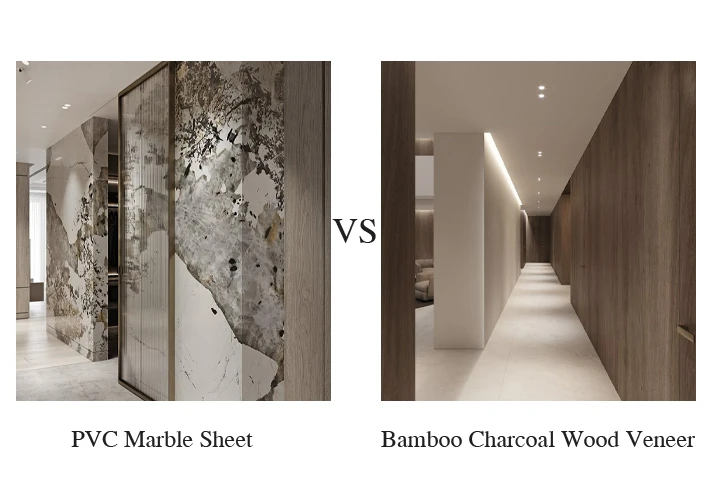
Material Composition and Structure
PVC Marble Sheet
PVC marble sheet, also known as PVC faux marble panel, is made from polyvinyl chloride (PVC) resin as the base material. It is typically composed of:
- PVC core layer
- Calcium carbonate filler
- UV coating
- Hot transfer printing film or laminated decorative layer
The surface mimics the look of natural marble, with high-gloss finishes that can resemble luxury stone.
Bamboo Charcoal Wood Veneer
Bamboo charcoal wood veneer is made from bamboo charcoal powder mixed with plant-based resin, then hot-pressed into panels. The surface is usually laminated with a wood-grain or matte decorative film.
This material is known for its eco-friendly composition, incorporating sustainable bamboo and often treated with formaldehyde-free adhesives.
Aesthetic Appearance
PVC Marble Sheet
- Designed to replicate natural marble and stone patterns
- Available in high-gloss, semi-gloss, and matte finishes
- Common patterns: Carrara white, black galaxy, onyx, and travertine
- Adds a luxurious, polished look to interiors
Bamboo Charcoal Veneer
- Mimics natural wood grain, bamboo textures, or even abstract patterns
- Typically comes in matte or satin finish
- Offers a warm, modern, minimalist style
- Often used in high-end contemporary interiors with a natural or Zen aesthetic
Conclusion:
PVC marble sheet is ideal for those looking for a stone-like luxury feel, while bamboo charcoal veneer is perfect for natural and warm interiors.
Environmental Performance
PVC Marble Sheet
- Made from synthetic resin and plastic, hence not biodegradable
- Often contains additives like plasticizers and stabilizers
- Some factories use eco-friendly, lead-free formulations, but not all do
- May release VOCs if not properly manufactured
Bamboo Charcoal Veneer
- Made from renewable bamboo and plant-based binders
- Naturally antibacterial, odor-absorbing, and formaldehyde-free
- Decomposable and low environmental impact
- Aligns with green building certification standards
Conclusion:
Bamboo charcoal veneer is significantly more environmentally friendly than PVC marble sheet, especially for projects with LEED or eco-certification requirements.
Durability and Maintenance
PVC Marble Sheet
- Waterproof and moisture-resistant
- Scratch-resistant surface (especially with UV coating)
- Flame-retardant grade: typically B1
- Easy to clean using water or neutral detergents
- Not suitable for very high-temperature environments
Bamboo Charcoal Veneer
- Good resistance to moisture but not completely waterproof
- More prone to scratches if not coated with protective film
- Usually achieves B1 fire retardant rating after treatment
- Requires gentle cleaning methods, no abrasive materials
Conclusion:
PVC marble sheets are better suited for wet areas such as bathrooms or kitchens. Bamboo charcoal veneer, although moisture-resistant, is better used in living rooms, bedrooms, and dry commercial spaces.
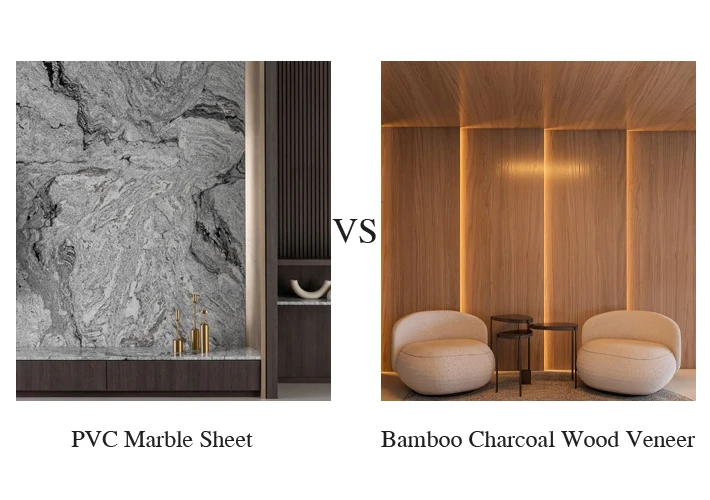
Application Scenarios
| Application Area | PVC Marble Sheet | Bamboo Charcoal Veneer |
|---|---|---|
| Hotel Lobby | ✅ Luxurious aesthetic | ✅ Warm, modern style |
| Bathroom | ✅ High waterproof rating | ❌ Not recommended |
| Kitchen Backsplash | ✅ Easy to clean | ❌ Sensitive to stains |
| Bedroom Accent Wall | ✅ Possible, but cold appearance | ✅ Warm, elegant, breathable |
| Commercial Office | ✅ Formal and sleek | ✅ Natural, relaxing environment |
| Elevator Panels | ✅ Glossy, scratch-resistant | ✅ Lightweight, less heat-sensitive |
| Furniture Surfacing | ✅ Often used for cabinet sides | ✅ Ideal for wardrobe panels, shelves |
Conclusion:
PVC marble sheet excels in wet or public-facing areas. Bamboo charcoal veneer is better for residential, hospitality, and office interiors that seek a cozy or eco-friendly image.
Installation Methods
PVC Marble Sheet
- Installed using adhesives or metal keels
- Lightweight, fast to install
- Can be cut on-site with basic tools
- Often used for quick renovation projects
Bamboo Charcoal Veneer
- Installed using nails, screws, or strong eco-glue
- Lightweight, but panels are more fragile than PVC
- More attention required for seam alignment
- Recommended for professional installation
Conclusion:
PVC marble sheet is more DIY-friendly and faster for large-scale commercial projects. Bamboo veneer installation requires more precision.
Product Size and Customization
| Feature | PVC Marble Sheet | Bamboo Charcoal Veneer |
|---|---|---|
| Standard Size | 1220×2440 mm | 1200×2400 mm or customized |
| Thickness | 2.5–4 mm | 5–9 mm standard |
| Surface Finish Options | Glossy, matte, 3D texture | Matte, wood-grain, brushed |
| Color Variety | 50+ marble styles | 100+ wood tones and custom patterns |
PVC marble sheets are available in more ready-made patterns, while bamboo charcoal veneer supports custom orders for OEM and branded applications.
Price Comparison
PVC Marble Sheet (FOB China)
- Average Price: $3.50–$6.00 per square meter
- Bulk Orders (20 ft container): As low as $2.80/m²
- More cost-effective for large projects
Bamboo Charcoal Veneer (FOB China)
- Average Price: $6.00–$12.00 per square meter
- Special patterns or acoustic models may go up to $15.00/m²
- Premium price due to eco-material and appearance
Conclusion:
PVC marble sheet is more affordable, while bamboo charcoal veneer is a premium eco-product with higher unit cost.

Export and Market Trends
PVC Marble Sheet
- High demand in Middle East, Africa, Southeast Asia, Latin America
- Popular for budget hotel chains, apartments, retail chains
- Export volumes increasing due to price competitiveness
Bamboo Charcoal Veneer
- Strong growth in Europe, North America, Japan, South Korea
- Preferred by designers and eco-conscious clients
- Popular in luxury projects, wellness spaces, soundproofing decoration
Conclusion:
PVC marble sheet dominates in cost-sensitive markets, while bamboo charcoal veneer is gaining traction in design-focused and eco-aware regions.
Which One Should You Choose?
| Criteria | Recommended Material |
|---|---|
| Budget Constraints | PVC Marble Sheet |
| Green Building Requirement | Bamboo Charcoal Veneer |
| Wet Area Usage | PVC Marble Sheet |
| Acoustic Function Needed | Bamboo Charcoal Veneer (with backing) |
| Fast Installation | PVC Marble Sheet |
| High-End Residential/Hotel Look | Bamboo Charcoal Veneer |
Conclusion
Both PVC marble sheets and bamboo charcoal wood veneers have their unique advantages and application niches. The best choice depends on your specific project requirements:
- If you’re working on cost-effective, fast-moving construction or public area cladding, PVC marble sheet is a reliable solution.
- If your project values aesthetics, sustainability, and interior warmth, bamboo charcoal wood veneer is worth the investment.
As a professional manufacturer and supplier in China, we provide both PVC marble sheets and bamboo charcoal wood veneers in bulk, supporting OEM, custom colors, and packaging services. We are committed to high quality control, on-time delivery, and strong export support for our B2B partners around the world.
Contact us today to get free samples, catalogues, and factory price lists.

